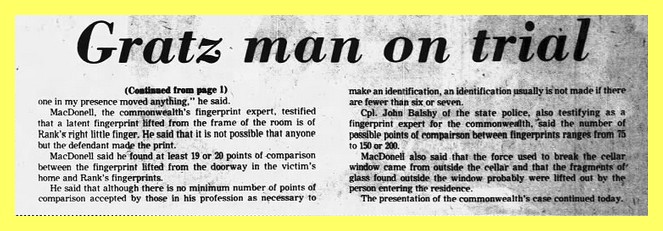On 22 March 1979, Helen E. Horn, a widow, returned home from an evening meeting of the Gratz Historical Society. Within minutes of entering her house, she was on her dining room floor – naked and dead in a pool of blood. Although someone was charged with her murder, at trial, he was acquitted. The crime was never solved.
This post is one of 19 chronicling the discovery of the body, the arrest and trial of the suspect, and his acquittal. The story is told through articles that appeared in a Pottsville newspaper.
From the Pottsville Republican, 21 September 1979
Gratz man on trial for Woman’s Murder
By SUE BOOKS, Staff Writer
HARISBURG – The murder trial of a 19-year-old Gratz resident was started in Dauphin County Court here Thursday after a three-day process of selecting the jury.
Because the death penalty is a possibility in the event of a first degree murder conviction, each potential juror was questioned by the presiding judge John C. Dowling, about possible objections to the penalty.
Gary Rank has been charged with the murder of a 68-year-old neighbor, Mrs. Helen Horn. The victim’s unclothed body was found on her dining room floor the morning of 23 March 1979.
Evidence presented by the commonwealth Thursday and during a preliminary hearing May 4 before District Magistrate Francis B. Reichenbach, Elizabethville, includes two partial fingerprints identified as Rank’s by two witnesses. Making the identification were Trooper Dean B. Shipe of the state police at Harrisburg. Troop H crime investigation unit, and professor Herbert L. MacDonell of Corning Community College in Corning, N.Y., called by the commonwealth as a fingerprint expert.
Defense attorney John J. Krafzig Jr., in his opening statement to the jury, claimed that it is not possible that Rank was at the scene of the crime when it was committed.
Although the exact time of death has not been determined, Mrs. Horn was last seen about 10 p.m. March 22. Circumstantial evidences established the time of the murder as just after 10 p.m. Krafsig argued, and Rank’s whereabouts until just before 11 p.m. the same night can be verified through testimony of persons with him.
The defense attorney also claimed that although a considerable amount of blood was found near the body, no blood was found on any of the defendant’s clothing. Nether was any paint or putty on his clothing which would be expected if, as the prosecuting attorney has claimed, a tiny cellar window was the route of entry, Krafzig told the jury.
One partial fingerprint, a latent or invisible print found on a doorway frame, was not picked up until 40 days later, on May 2, the defense attorney pointed out. The suspect was arrested April 24.
Slides showing Mrs. Horn’s residence and the way the body was found by police, which were filmed by Shipe when he arrived on the scene March 23, were shown to the jury.
Deputy District Attorney Joseph Kleinfelter, the prosecuting attorney, called Mrs. Mary Hepler, who found the victim’s body about 7:30 a.m. March 23, to testify about the slides and what she saw.
Mrs. Hepler, who knew Mrs. Horn about 43 years and did housework for her for almost 24 years, said that when she approached the Horn residence March 23 she noted with surprise that the cellar door was ajar.
She said she went in the door and up the stairs leading to the dining room, where she saw the body. The victim’s head was covered with a couple of rugs from the house. Mrs. Hepler threw a raincoat over the body, she said, and ran upstairs “to make sure it was her.”
I knew she was dead, but I just didn’t want to believe that was her,” she recalled. She said she then came back downstairs, ran to a neighbor’s house, and they drove to the coroner’s office from which the police were called.
A radio in the dining room was on when she came in, Mrs. Hepler said, and it was Mrs. Horn’s habit to plug he radio in when she came in at night to listen to the news.
The defense attorney argued that the fact that the radio was playing, as well as indications that Mrs. Horn had not personally removed her underclothes or fed any of her 16-18 cats, suggests that she was murdered just after she came home that night. Mrs. Hepler said Mrs. Horn usually fed some of the cats very shortly after she came in.
Mrs. Helper denied that one of the slides filmed by Shipe accurately represents the room as she found it. The slide shows a chair in the dining room with boxes stacked on the seat and Mrs. Horn’s pocket book sitting on top.
There were no boxes on the chair seat, Mrs. Hepler said.
The witness also confirmed a statement she made during the preliminary hearing. “I don’t see how anyone could have gotten in there (the cellar window claimed to be the point of entry) without breaking his neck,” Mrs. Hepler testified in May.
Shipe disputed part of her testimony.
“The slide (of the chair) clearly depicts the scene as I saw it. No one in my presence moved anything,” he said.
MacDonell, the commonwealth’s fingerprint expert, testified that a latent fingerprint was lifted from the frame of the room is of Rank’s little finger. He said that it is not possible that anyone but the defendant made the print.
MacDonell said he found at least 19 or 20 points of comparison between the fingerprint lifted from the doorway in the victim’s home and Rank’s fingerprints.
He said that although there is no minimum number of points of comparison accepted by those in his profession as necessary to make an identification, as identification usually is not made if there are fewer than six or seven.
Cpl. John Balshy of the state policy, also testifying as a fingerprint expert for the commonwealth, said the number of possible points of comparison between fingerprints ranges from 75 to 150 or 200.
MacDonell also said that the force used to break the cellar window came from outside the cellar and that the fragments of glass found outside the window probably were lifted out by the person entering the residence.
The presentation of the commonwealth’s case continued today.
____________________________________
For all other parts of this story, see: Who Killed Helen Horn?
News clipping/article from Newspapers.com.
Corrections and additional information should be added as comments to this post.

